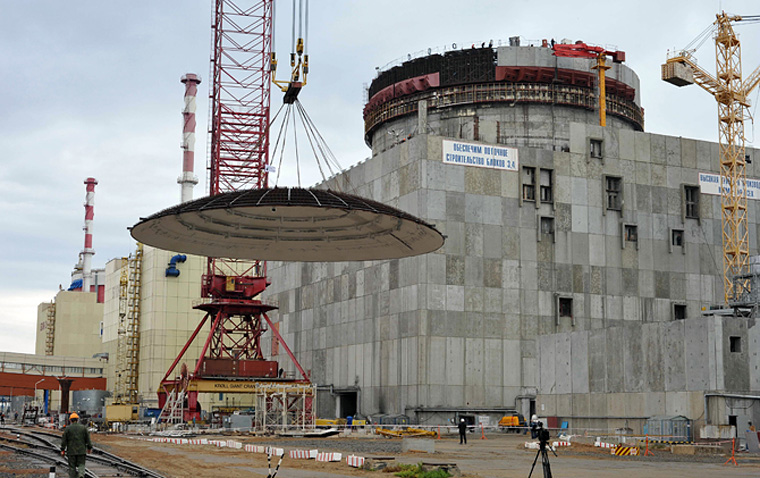
Reactors getting ready for start-up
back to contents“Today’s state of business at the power unit allows us stating confidently that it can be connected to the grid this year,” Valery Limarenko, President of the United Company NIAEP-ASE, said in his turn. “Certainly, a large amount of work has to be done to this end at all preceding stages, primarily, at the off-site infrastructure facilities, to ensure that they are ready for start-up and alignment. This will require much effort from all who work on the site, but I’m certain that we will cope and complete the project on schedule,” he continued.
The cold and hot runs have started at Unit 3 of Rostov NPP, which marks the most important stage of tests before the first criticality. Now, the cold run phase is under way, i.e. preparations for pressure tests and circulation flushing (PT and CF). At this stage the primary piping is filled with water and then pressure is raised up to 35 atmospheres and then, further, up to 250 atmospheres. In August the reactor will be under the hot runs. The specialists will be able to measure various parameters of the equipment: heat release, heat losses, coolant flow rate etc. that confirm safety of the reactor and demonstrate that its operation meets the design requirements.
Alexander Polushkin, Senior Vice President for Project Management at NIAEP-ASE, noted that the start of PT and CF was the evidence that the reactor construction was on schedule. “I would like to note a high degree of completion of the construction and installation as well as the as-built documents for this stage; this is a merit of all those who work on the site,” he said.
Meantime, the fire-extinguishing system equipment was tested in the turbine hall of the unit under construction. The fire water monitors were tested for efficiency in spraying the roof trusses.
“The roof truss spraying system is required to prevent the roof collapse if turbine oil catches fire,” Karen Tatarov, Deputy Head of the Turbine Shop No. 2, explained. “The work under this program is to test the water monitors for their water release; with that, the range and height of jet and flow rate of the monitors are determined. Also, the possibility of horizontal and vertical adjustment of the monitors is tested. The tests were passed successfully,” he said.
At the same time, specialists of Atomenergoremont (a ROSATOM’s division for maintenance, repair and refurbishment of nuclear power plants) carried out a unique operation at the turbine set of the unit under construction. They were successful in putting the generator rotor into the stator bore using a trolley with laser guidance especially designed for this operation. This was the first experience in using this approach. “The equipment helps put the rotor into stator while controlling the movement at up to a millimeter-wise accuracy,” Sergey Besedin, Director of Volgodonsk Branch of Atomenergoremont, said. “The rotor weights 160 tons and its length is slightly more than 11 meters. Previously, this work was done using a crane and extra staff, now the operation has become safer and more optimal in terms of time and man-hours,” he added.
There is one more reactor unit, which is getting ready for start-up in the end of 2014. It is Unit 1 of Novovoronezh nuclear power plant Phase II. Now, the installation of the first of three diesel generators is under way on this site. The diesel power station is a back-up power source for the safety systems. If necessary, the diesels (6 MW capacity each) will power the critical equipment and process systems of the plant. The generator turns on automatically at an emergency protection system’s signal. The diesel generator was already delivered from the heavy items storage pad to the back-up diesel power station building of the emergency power supply system and was installed inside. At the next stage, specialists will start installing the process and electrical systems of the diesel power station. The diesel generator is planned to start in the fourth quarter of this year.
In the recent days, at Novovoronezh Phase II another stage of the in-house power program was completed. This is a key milestone of the power unit construction. Power supply, which is arranged as for normal operation, allows starting full-scale start-up operations at the electrical equipment.
After connection to the grid BN-800 will operate until the first scheduled refueling with the initial core charge made up at this particular stage. It includes the starting neutron source, 648 fuel assemblies, and 36 assemblies of the reactor control and protection system.
At the present time, at Beloyarsk NPP the necessary tests and measurements are carried out to confirm design neutronics of the BN-800 reactor core. The first power of the unit is planned for the fall 2014. At the first power stage the reactor power will be 25% of the rated value. Then, it will be gradually built up to reach 100%. The power unit commissioning for the commercial operation will be in 2015.




